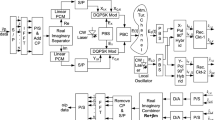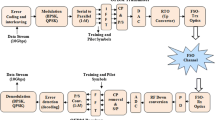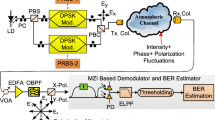Abstract
Polarization division multiplexing (PDM) is a promising technique to increase the capacity of future free-space optical (FSO) system due to availability of optical PDM multiplexer/demultiplexer. However, there are limitations due to cross-polarization-induced crosstalk and atmospheric turbulence. A novel analytical model of a DQPSK PDM FSO link is analyzed in this paper to determine the deterioration in error rate performance considering the cross-polarization-induced crosstalk in the presence of atmospheric turbulence. A closed-form expression for signal-to-crosstalk plus noise ratio and bit error rate conditioned on a given turbulence-induced fading and a given angular misalignment due to cross-polarization at the output of optical PDM DQPSK receiver is derived. By averaging the conditional BER, the average BER is found over the probability density function of the turbulence considering a log-normal distribution and random angular misalignment which is considered to have a Maxwellian distribution. The results are given in terms of BER and system power penalty because of cross-polarization-induced crosstalk with the effect of weak atmospheric turbulence. It is noticed that system BER performance degrades significantly and power penalty is found to almost 8.2 dB, 9.2 dB and 12 dB for mean misalignment angle of 4°, 5° and 6°, respectively, at a BER of 10−10 and a given turbulence parameter C2n = 10−14m−2/3. Finally, our analytical work is verified with others earlier published work.
Similar content being viewed by others
Avoid common mistakes on your manuscript.
Introduction
Free-space optical (FSO) communication is an emerging technology for broadband wireless optical communication system because of its high bandwidth, spectrum without licensed, high bit rates, with very high transmission security and low hardware cost [1,2,3]. Recently, FSO is widely considered as an alternate technology for near-ground radio-frequency wireless short-range connections and also considered for long-distance communication, such as satellite communications [1]. Atmospheric turbulence provides distortion in signal intensity, and cross-polarization induces crosstalk in the received signal which severely limits the performance of a FSO communication system and also degrades the bit error rate performance significantly [4,5,6,7,8]. Commercially, FSO system considered only intensity modulation direct detection technique which is not suitable for atmospheric turbulence, causing scintillation and degrades the system performance [6]. The random intensity fluctuations of the propagating light wave increases when passing through the atmospheric turbulence due to the presence of refractive index structure parameter (C2n ) [7]. Recent works on FSO considered the polarization state of the light beam to be stable, and the effect of cross-polarization due to atmospheric turbulence is not taken into account [9,10,11]. In [12], the authors reported the polarization effect on the system bit error rate (BER) performance considering Gaussian distribution of phase fluctuation in the presence of atmospheric turbulence. More recently, research works are reported where polarization shift keying modulation technique is considered to reduce the phase noise produce by the laser [13, 14]. In Ref. [15], the authors considered the optical fiber transmission with cross-polarization-induced crosstalk effect on a polarization division multiplexing-quadrature phase shift keying (PDM-QPSK) system with coherent homodyne detection.
An analytical approach is presented in this paper to determine the BER performance of a polarization division multiplexing followed by differential quadrature phase shift keying (DQPSK) FSO communication system taking into account the cross-polarization-induced crosstalk and fading effect of atmospheric turbulence. A closed-form expression for signal-to-crosstalk plus noise ratio is developed. The BER performance conditioned on a given value of turbulence, and a given angular misalignment of the polarization states is developed. By averaging the system conditional BER, system average BER is found over the probability density function of the turbulence which is considering as log-normal distribution and the probability density function of the polarization fluctuation which is considered as Maxwellian distribution.
System model
A detail block diagram of a polarization division multiplexing coherent DQPSK FSO system is shown in Fig. 1. For optical DQPSK modulator, dual drive Mach–Zehnder interferometer (DD-MZI) is required which contains two MZIs, one for in-phase and another for quadrature phase components [16,17,18]. The polarization beam splitter splits the input continuous wave laser electric field at the transmitter which is orthogonally polarized and passed through two optical QPSK modulators. For X and Y polarizations, the phase difference between them is 90°. Each modulator modulates the laser output with in-phase (I) and quadrature phase (Q) data indexed by XI,k and XQ,k, respectively. The polarized light is combined by using a PBC and transmitted through turbulent channel. The received signal is split by PBS and fed to the upper 90° hybrid for X-polarized light and lower 90° hybrid for Y-polarized light. The 45° linearly polarized output light from a local oscillator with respect to the received polarization is also feed by the two 90° hybrids. By applying homodyne balance detection techniques, the data decision is carried out from the receiver circuit.
Theoretical analysis
Analysis of transmitted signal
The electric field of the resultant optical signal from the output of the PBC and input to the atmospheric channel can be represented as [15]:
where m denotes I or Q which is representing in-phase and quadrature phase, respectively, p denotes X or Y which is representing horizontal and vertical polarization, respectively, and the symbol period, Ts = 2 Tb, Tb represents the bit duration and symbol energy, Es = 2Eb, Eb representing the bit energy, p(t) representing the pulse shape function, optical carrier frequency represented by ω0 and Φs is the laser phase noise.
Analysis of received signal
The input signal to the PBS is represented as [15]
where
The detail of 90° hybrid with receiver circuit used in Fig. 1 is shown in Fig. 2.
The local oscillator output signal which is the input of the X-Pol 90° hybrid can be expressed as [15]:
The subchannels random rotation due to the presence of turbulence, the signal suffered fading and crosstalk. The state of polarizations at the PBS, the input signal of the X-Pol 90° hybrid can be expressed as [15]:
where ɛF is the coefficient of complex fading due to X-polarization and ɛX is the complex crosstalk coefficient due to Y-polarization. The magnitude of this coefficient can be written as [12, 19]:
The instantaneous output at the port C1 of the X-Pol 90° hybrid, after neglecting common losses, can be expressed as:
Neglecting the optical frequency term as well as the sine and quadrature terms because they will not generate any in-phase signal, the resultant signal can be written as [15]:
After neglecting the time dependence and multiplying with conversion parameter K, the output power can be expressed for the port C1 is [15],
Similarly, the power at port C2,
The differential photocurrents from the output port C1 and C2 are written by:
Now the signal terms after considering fading due to PBS misalignment and turbulence is:
And the crosstalk terms due to X-Pol and turbulence is:
Analysis of SNR and BER
The conditional signal-to-crosstalk plus noise ratio (SCNR) condition on turbulence and misalignment angle is represent as:
Now the conditional BER is given by:
The probability density function of turbulence-induced fading I, is taken as log-normal distribution for weak atmospheric turbulence which is given by [20]:
Finally, the BER average is given by [21]:
where fθ(θ) represents the probability density function of random misalignment angle θ, which is modeled as Maxwellian distribution [15, 22]:
where θm. represents the mean misalignment angle of the random rotations.
Results and discussion
Following the analytical approach, we determine the system BER performance of a FSO link considering polarization division multiplexing optical DQPSK modulation with coherent homodyne detection. Table 1 contains the parameters that are used for numerical simulation. In Fig. 3, the plots of bit error rate as a function of received optical signal power are depicted for different cases of without turbulence, with turbulence and without and with polarization-induced crosstalk. The results show that system severely affected in BER performance because of polarization-induced crosstalk as well as atmospheric turbulence.
The effect of crosstalk and fading only due to the misalignment angle of the received signal is shown in Fig. 4. When atmospheric turbulence is added along with this effect, the resultant BER performance degrades severely which is shown in Fig. 5. The results show that degradation in BER performance and power penalty occurs significantly which is found to 8.2 dB, 9.2 dB and 12 dB for mean misalignment angle of 4°, 5° and 6°, respectively, at a BER of 10−10 for a FSO link with distance of 1000 m considering a given turbulence parameter of C2n = 10−14m−2/3.
The system BER performance improvement due to the increase in local oscillator power is shown in Fig. 6. When local oscillator power increases, it is in fact increases the signal-to-noise ratio of the received signal. So the bit error rate performance improves when local oscillator power increases. The result shows that almost 5.1 dB improvement in receiver sensitivity occurs due to increase in the local oscillator power from 1 to 10 mW. The system BER performance with respect to received optical signal power under turbulent condition is provided in Fig. 7 with link distance as a parameter and considering mean misalignment angle of 4°. As expected, the performance degrades due to the increase in link distance because it increases signal fading. It is also shown that the allowable link distance for proposed system is 3650 m at a BER of 10−11 considering the mean misalignment angle is 4° because of the effect of atmospheric turbulence. The power penalty increases due to increase in the mean misalignment angle of the received signal as shown in Fig. 8 considering both with and without atmospheric turbulence at a BER of 10−10. It is noticed that signal suffers almost 7 dB, 7.9 dB, 9.7 dB and 16.7 dB more power penalty due to atmospheric turbulence for link distance of 1000 m, 2000 m, 3000 m and 3650 m, respectively. Figure 9 shows the plots of receiver sensitivity degradation for different values of mean angular misalignment to obtain a BER of 10−8 considering link distance as an input variable. This receiver sensitivity degradation curve is found from the system BER performance curves. The result shows as expected that when link distance increases, the receiver sensitivity degradation is higher and also when mean misalignment angle increases, the receiver sensitivity degradation is also higher. Finally, the results of our proposed analytical system are compared with the experimental results of Ref. [23] and also compared with the published work in Ref. [15] which is shown in Figs. 10 and 11, respectively. It is noticed that our results are in commensurate with the published results.
Compare the results of our proposed work with the experimental results in Ref. [23]
Performance comparison curve between our proposed work (PDM FSO) and Ref. [15] which is PDM optical fiber communication
Conclusions
Analysis is presented for a polarization division multiplexing optical DQPSK link over free-space optical channel taking into consideration the combined influence of cross-polarization-induced crosstalk and atmospheric turbulence. The results are evaluated numerically taking into account the probability density function of the polarization fluctuation to be Maxwellian distribution. It is noticed that significant deterioration in system BER performance occurs because of above effects and due to cross-polarization-induced crosstalk, and system suffers severe power penalty. The results may used to find application in design of PDM optical FSO link over turbulent channel.
References
P. Wang, L. Zhang, L. Guo, F. Huang, T. Shang, R. Wang, Y. Yang, Average BER of subcarrier intensity modulated free space optical systems over the exponentiated Weibull fading channels. Opt. Express 22(17), 20828–20841 (2014)
S.W.C. Vincent, Free-space optical communications. J. Lightw. Technol. 24, 4750–4762 (2006)
S.V. Chinta, T.P. Kurzweg, D.S. Pfeil, K.R. Dandekar, “4 × 4 space–time codes for free space optical interconnects, in Photonics Packaging, Integration, and Interconnects. Proceedings of the SPIE, vol. 7221, pp. 722116–722116-8 (2009)
G.Z. Antonio, Error rate performance for STBC in free-space optical communications through strong atmospheric turbulence. IEEE Commun. Lett. 11, 390–392 (2007)
X. Zhu, J.M. Kahn, Free-space optical communication through atmospheric turbulence channels. IEEE Trans. Commun. 50, 1293–1300 (2002)
R. Zhang, P.C. Peng, X. Li, S. Liu, Q. Zhou, J. He, Y.W. Chen, S. Shen, S. Yao, G.K. Chang, 4 × 100 -Gb/s PAM-4 FSO transmission based on polarization modulation and direct detection. IEEE Photonics Technol. Lett. 31(10), 755–758 (2019)
K. Sunilkumar, N. Anand, S.K. Satheesh, K.K. Moorthy, G. Ilavazhagan, Performance of free-space optical communication systems: effect of aerosol-induced lower atmospheric warming. Opt. Express 27, 11303–11311 (2019)
B. Barua, S.P. Majumder, Bit error rate analysis of an OFDM subcarrier modulated FSO link with optical intensity modulated and a direct detection receiver. Int. J. Opt. Photonic Eng. UK 4, 1–11 (2018)
J. Grosinger, Investigation of Polarization Modulation in Optical Free Space Communications Through THe Atmosphere. vol. master: Technical University of Vienna (2008)
S.A.J. Flrez, Circular polarization and availability in free space optics (FSO) communication systems, in IEEE Latin-American Conference on Communications (LATINCOM), pp. 1–6 (2010)
G.D. Xie, F.X. Wang, A. Dang, H. Guo, A novel polarization-multiplexing system for free-space optical links. IEEE Photonics Technol. Lett. 23, 1484–1486 (2011)
J. Zhang, Z. Li, A. Dang, Performance of wireless optical communication systems under polarization effects over atmospheric turbulence. J. Opt. Commun. 416, 207–213 (2018)
M.M. Karbassian, H. Ghafouri-Shiraz, Transceiver architecture for incoherent optical CDMA network based on polarization modulation. J. Lightw. Technol. 26, 3820–3828 (2008)
X. Zhao, Y. Yao, Y. Sun, C. Liu, Circle polarization shift keying with direct detection for free-space optical communication. Opt. Commun. Netw. 1, 307–312 (2009)
Taher, K.A., Majumder, S.P.: Analytical evaluation of the effect of cross-polarization-induced crosstalk on the BER performance of a PDM-QPSK coherent homodyne optical transmission system. J. Opt. Commun. (2016). https://doi.org/10.1515/joc-2016-0072
T.Y. Liow, X. Tu, G.Q. Lo, D.L. Kwang, K. Goi, A. Oka, H. Kusaka, K. Ogawa, Silicon quadrature phase-shift-keying modulator for 40- and 100-Gb/s transmission, Fujikura Tech. Rev., pp. 1–5 (2014)
G.H. Smith, D. Novak, Overcoming chromatic-dispersion effects in fiber-wireless systems incorporating external modulators. IEEE Trans. Microwave Theory Tech. 45, 1410–1415 (1997)
G.D. Houser, E. Garmire, Balanced detection technique to measure small changes in transmission. Appl. Opt. 33(1994), 1059–1062 (1994)
M. Winter, C.A. Bunge, D. Setti, K. Petermann, A statistical treatment of cross polarization modulation in DWDM systems. J. Lightw. Technol. 27, 3739–3751 (2009)
M.S. Islam, S.P. Majumder, Performance analysis of a free space optical link using Alamouti type space time block code with weak turbulent condition, in 7th ICECE COnference, (2012). https://doi.org/10.1109/icece.2012.6471542
J. Zhang, A. Dang, Performance analysis of free space optical communication under atmospheric polarization effect. in Asia Communication and Photonics Conference (ACP), OSA (2017)
C. Glauco, P. Simoes, C. Floridia, C. Franciscangelis, M.C. Argentato, M.A. Romero, Simultaneous nominal and effective differential group delay in service monitoring method for optical communication systems. Opt. Express 21, 8190–8820 (2013)
J.M. Ostermann, P. Debernardi, Polarization division multiplexed data transmission using surface grating VCSELs, in Institute of Optoelectronics, Ulm University, Annual report, pp. 71–76 (2008)
Author information
Authors and Affiliations
Corresponding author
Additional information
Publisher's Note
Springer Nature remains neutral with regard to jurisdictional claims in published maps and institutional affiliations.
Rights and permissions
About this article
Cite this article
Islam, M.S., Majumder, S.P. Performance analysis of a two-channel polarization division multiplexed optical DQPSK FSO link with the effect of atmospheric turbulence. J Opt 49, 357–363 (2020). https://doi.org/10.1007/s12596-020-00628-0
Received:
Accepted:
Published:
Issue Date:
DOI: https://doi.org/10.1007/s12596-020-00628-0















